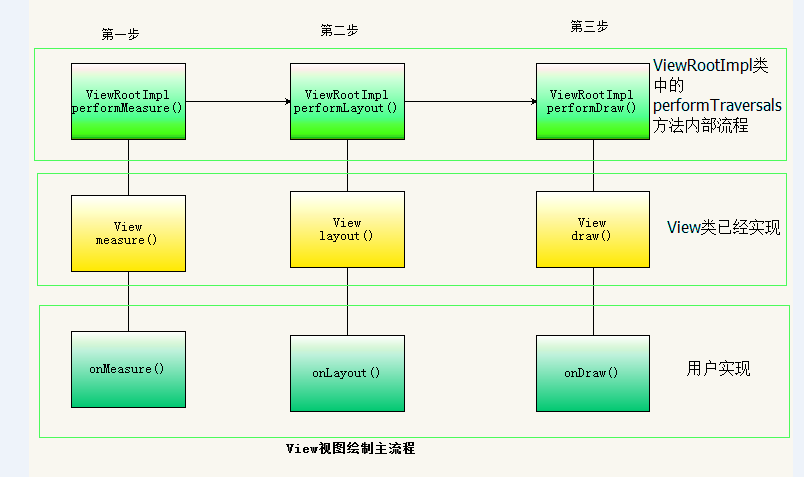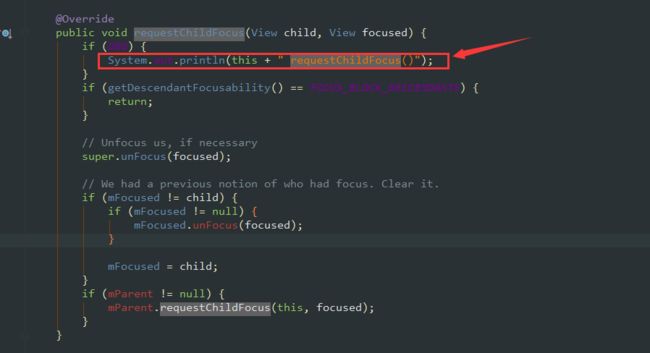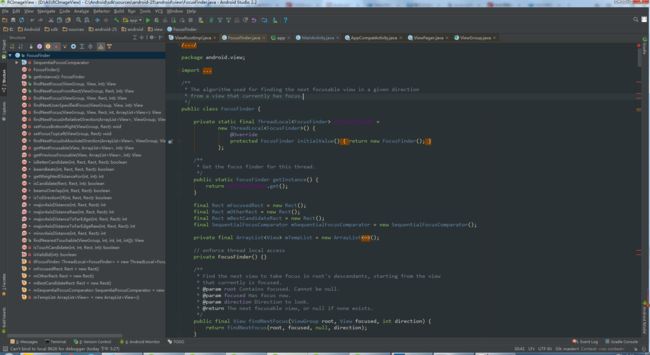如果您对TouchEvent事件分发机制不太了解的,可以参考我的这篇文章——安卓TounchEvent事件分发机制。
问题:TV端焦点满天飞,如何解决和处理?
记得初入TV开发,以为很简单。TV的这些界面与布局太简单了,分分钟就可以把页面搭建出来,处理好,然后就没有然后了。。。。
下面我们就从源码来带大家进行安卓TV焦点事件的传递
这里先给出Android系统View的绘制流程:
依次执行View类里面的如下三个方法:
- measure(int ,int) :测量View的大小
- layout(int ,int ,int ,int) :设置子View的位置
- draw(Canvas) :绘制View内容到Canvas画布上
ViewRootImpl的主要作用如下(此处不多讲,如有意图,看源码):
A:链接WindowManager和DecorView的纽带,更广一点可以说是Window和View之间的纽带。
B:完成View的绘制过程,包括measure、layout、draw过程。
C:向DecorView分发收到的用户发起的event事件,如按键,触屏等事件。
ViewRootImpl不再多余叙述,进入正题:
Android焦点分发的主要方法以及拦截方法的讲解。
在RootViewImpl中的函数通道是各种策略(InputStage)的组合,各策略负责的任务不同,如SyntheticInputStage、ViewPostImeInputStage、NativePostImeInputStage等等,这些策略以链表结构结构起来,当一个策略者没有消费事件时,就传递个下一个策略者。其中触摸和按键事件由ViewPostImeInputStage处理。
@Override
protected int onProcess(QueuedInputEvent q) {
if (q.mEvent instanceof KeyEvent) {
return processKeyEvent(q);//如果是按键事件走此处,处理按键和焦点问题了
} else {
final int source = q.mEvent.getSource();
if ((source & InputDevice.SOURCE_CLASS_POINTER) != 0) {
return processPointerEvent(q);//如果是触摸事件走此处
} else if ((source & InputDevice.SOURCE_CLASS_TRACKBALL) != 0) {
return processTrackballEvent(q);
} else {
return processGenericMotionEvent(q);
}
}
}
processKeyEvent(QueuedInputEvent q)源码如下:
@Override
protected void onDeliverToNext(QueuedInputEvent q) {
if (mUnbufferedInputDispatch
&& q.mEvent instanceof MotionEvent
&& ((MotionEvent)q.mEvent).isTouchEvent()
&& isTerminalInputEvent(q.mEvent)) {
mUnbufferedInputDispatch = false;
scheduleConsumeBatchedInput();
}
super.onDeliverToNext(q);
}
private int processKeyEvent(QueuedInputEvent q) {
final KeyEvent event = (KeyEvent)q.mEvent;
// Deliver the key to the view hierarchy.
if (mView.dispatchKeyEvent(event)) {
return FINISH_HANDLED;
}
if (shouldDropInputEvent(q)) {
return FINISH_NOT_HANDLED;
}
// If the Control modifier is held, try to interpret the key as a shortcut.
if (event.getAction() == KeyEvent.ACTION_DOWN
&& event.isCtrlPressed()
&& event.getRepeatCount() == 0
&& !KeyEvent.isModifierKey(event.getKeyCode())) {
if (mView.dispatchKeyShortcutEvent(event)) {
return FINISH_HANDLED;
}
if (shouldDropInputEvent(q)) {
return FINISH_NOT_HANDLED;
}
}
// Apply the fallback event policy.
if (mFallbackEventHandler.dispatchKeyEvent(event)) {
return FINISH_HANDLED;
}
if (shouldDropInputEvent(q)) {
return FINISH_NOT_HANDLED;
}
// Handle automatic focus changes.
if (event.getAction() == KeyEvent.ACTION_DOWN) {
int direction = 0;
switch (event.getKeyCode()) {
case KeyEvent.KEYCODE_DPAD_LEFT:
if (event.hasNoModifiers()) {
direction = View.FOCUS_LEFT;
}
break;
case KeyEvent.KEYCODE_DPAD_RIGHT:
if (event.hasNoModifiers()) {
direction = View.FOCUS_RIGHT;
}
break;
case KeyEvent.KEYCODE_DPAD_UP:
if (event.hasNoModifiers()) {
direction = View.FOCUS_UP;
}
break;
case KeyEvent.KEYCODE_DPAD_DOWN:
if (event.hasNoModifiers()) {
direction = View.FOCUS_DOWN;
}
break;
case KeyEvent.KEYCODE_TAB:
if (event.hasNoModifiers()) {
direction = View.FOCUS_FORWARD;
} else if (event.hasModifiers(KeyEvent.META_SHIFT_ON)) {
direction = View.FOCUS_BACKWARD;
}
break;
}
if (direction != 0) {
View focused = mView.findFocus();
if (focused != null) {
View v = focused.focusSearch(direction);
if (v != null && v != focused) {
// do the math the get the interesting rect
// of previous focused into the coord system of
// newly focused view
focused.getFocusedRect(mTempRect);
if (mView instanceof ViewGroup) {
((ViewGroup) mView).offsetDescendantRectToMyCoords(
focused, mTempRect);
((ViewGroup) mView).offsetRectIntoDescendantCoords(
v, mTempRect);
}
if (v.requestFocus(direction, mTempRect)) {
playSoundEffect(SoundEffectConstants
.getContantForFocusDirection(direction));
return FINISH_HANDLED;
}
}
// Give the focused view a last chance to handle the dpad key.
if (mView.dispatchUnhandledMove(focused, direction)) {
return FINISH_HANDLED;
}
} else {
// find the best view to give focus to in this non-touch-mode with no-focus
View v = focusSearch(null, direction);
if (v != null && v.requestFocus(direction)) {
return FINISH_HANDLED;
}
}
}
}
return FORWARD;
}
进入源码讲解:
(1) 首先由dispatchKeyEvent进行焦点的分发
如果dispatchKeyEvent方法返回true,那么下面的焦点查找步骤就不会继续了。
dispatchKeyEvent方法返回true代表事件(包括焦点和按键)被消费了。
dispatchKeyEvent(event)如果不了解,看我上一篇文章安卓TounchEvent事件分发机制。
mView的dispatchKeyEvent方法,
mView是是Activity的顶层容器DecorView,它是一FrameLayout。
所以这里的dispatchKeyEvent方法应该执行的是ViewGroup的dispatchKeyEvent()方法,而不是View的dispatchKeyEvent方法。
@Override
public boolean dispatchKeyEvent(KeyEvent event) {
if (mInputEventConsistencyVerifier != null) {
mInputEventConsistencyVerifier.onKeyEvent(event, 1);
}
if ((mPrivateFlags & (PFLAG_FOCUSED | PFLAG_HAS_BOUNDS))
== (PFLAG_FOCUSED | PFLAG_HAS_BOUNDS)) {
if (super.dispatchKeyEvent(event)) {
return true;
}
} else if (mFocused != null && (mFocused.mPrivateFlags & PFLAG_HAS_BOUNDS)
== PFLAG_HAS_BOUNDS) {
if (mFocused.dispatchKeyEvent(event)) {
return true;
}
}
if (mInputEventConsistencyVerifier != null) {
mInputEventConsistencyVerifier.onUnhandledEvent(event, 1);
}
return false;
}
ViewGroup的dispatchKeyEvent简略执行流程
首先ViewGroup会执行父类的dispatchKeyEvent方法,如果返回true那么父类的dispatchKeyEvent方法就会返回true,也就代表父类消费了该焦点事件,那么焦点事件自然就不会往下进行分发。
然后ViewGroup会判断mFocused这个view是否为空,如果为空就会****return false,焦点继续往下传递;如果不为空,那就会return mFocused的dispatchKeyEvent方法返回的结果。这个mFocused是ViewGroup中当前获取焦点的子View,这个可以从requestChildFocus方法中得到答案。
requestChildFocus()的源码如下:
@Override
public void requestChildFocus(View child, View focused) {
if (DBG) {
System.out.println(this + " requestChildFocus()");
}
if (getDescendantFocusability() == FOCUS_BLOCK_DESCENDANTS) {
return;
}
// Unfocus us, if necessary
super.unFocus(focused);
// We had a previous notion of who had focus. Clear it.
if (mFocused != child) {
if (mFocused != null) {
mFocused.unFocus(focused);
}
mFocused = child;
}
if (mParent != null) {
mParent.requestChildFocus(this, focused);
}
}
居然有这个彩蛋?
View的dispatchKeyEvent简略执行流程
public boolean dispatchKeyEvent(KeyEvent event) {
if (mInputEventConsistencyVerifier != null) {
mInputEventConsistencyVerifier.onKeyEvent(event, 0);
}
// Give any attached key listener a first crack at the event.
//noinspection SimplifiableIfStatement
ListenerInfo li = mListenerInfo;
if (li != null && li.mOnKeyListener != null && (mViewFlags & ENABLED_MASK) == ENABLED
&& li.mOnKeyListener.onKey(this, event.getKeyCode(), event)) {
return true;
}
if (event.dispatch(this, mAttachInfo != null
? mAttachInfo.mKeyDispatchState : null, this)) {
return true;
}
if (mInputEventConsistencyVerifier != null) {
mInputEventConsistencyVerifier.onUnhandledEvent(event, 0);
}
return false;
}
要修改ViewGroup焦点事件的分发:
- 重写view的dispatchKeyEvent方法
- 给某个子view设置onKeyListener监听
焦点没有被dispatchKeyEvent拦截的情况下的继续代码中的处理过程,还是进入ViewRootImpl源码
// Handle automatic focus changes.
if (event.getAction() == KeyEvent.ACTION_DOWN) {
int direction = 0;
switch (event.getKeyCode()) {
case KeyEvent.KEYCODE_DPAD_LEFT:
if (event.hasNoModifiers()) {
direction = View.FOCUS_LEFT;
}
break;
case KeyEvent.KEYCODE_DPAD_RIGHT:
if (event.hasNoModifiers()) {
direction = View.FOCUS_RIGHT;
}
break;
case KeyEvent.KEYCODE_DPAD_UP:
if (event.hasNoModifiers()) {
direction = View.FOCUS_UP;
}
break;
case KeyEvent.KEYCODE_DPAD_DOWN:
if (event.hasNoModifiers()) {
direction = View.FOCUS_DOWN;
}
break;
case KeyEvent.KEYCODE_TAB:
if (event.hasNoModifiers()) {
direction = View.FOCUS_FORWARD;
} else if (event.hasModifiers(KeyEvent.META_SHIFT_ON)) {
direction = View.FOCUS_BACKWARD;
}
break;
}
if (direction != 0) {
View focused = mView.findFocus();
if (focused != null) {
View v = focused.focusSearch(direction);
if (v != null && v != focused) {
// do the math the get the interesting rect
// of previous focused into the coord system of
// newly focused view
focused.getFocusedRect(mTempRect);
if (mView instanceof ViewGroup) {
((ViewGroup) mView).offsetDescendantRectToMyCoords(
focused, mTempRect);
((ViewGroup) mView).offsetRectIntoDescendantCoords(
v, mTempRect);
}
if (v.requestFocus(direction, mTempRect)) {
playSoundEffect(SoundEffectConstants
.getContantForFocusDirection(direction));
return FINISH_HANDLED;
}
}
// Give the focused view a last chance to handle the dpad key.
if (mView.dispatchUnhandledMove(focused, direction)) {
return FINISH_HANDLED;
}
} else {
// find the best view to give focus to in this non-touch-mode with no-focus
View v = focusSearch(null, direction);
if (v != null && v.requestFocus(direction)) {
return FINISH_HANDLED;
}
}
}
}
dispatchKeyEvent方法返回false后,先得到按键的方向direction一个int值。direction值是后面来进行焦点查找的。
接着会调用DecorView的findFocus()方法一层一层往下查找已经获取焦点的子View。
DecorView则是PhoneWindow类的一个内部类,继承于FrameLayout,由此可知它是一个ViewGroup。
那么,DecroView到底充当了什么样的角色呢?
其实,DecorView是整个ViewTree的最顶层View,它是一个FrameLayout布局,代表了整个应用的界面。在该布局下面,有标题view和内容view这两个子元素。
@Override
public View findFocus() {
if (DBG) {
System.out.println("Find focus in " + this + ": flags="
+ isFocused() + ", child=" + mFocused);
}
if (isFocused()) {
return this;
}
if (mFocused != null) {
return mFocused.findFocus();
}
return null;
}
View的findFocus方法
/**
* Find the view in the hierarchy rooted at this view that currently has
* focus.
*
* @return The view that currently has focus, or null if no focused view can
* be found.
*/
public View findFocus() {
return (mPrivateFlags & PFLAG_FOCUSED) != 0 ? this : null;
}
View的hasFocus()方法和isFocused()方法对比
Stackoverflow解释来了:
hasFocus() is different from isFocused(). hasFocus() == true means that the View or one of its descendants is focused. If you look closely, there's a chain of hasFocused Views till you reach the View that isFocused.
/**
* Returns true if this view has focus itself, or is the ancestor of the
* view that has focus.
*
* @return True if this view has or contains focus, false otherwise.
*/
@ViewDebug.ExportedProperty(category = "focus")
public boolean hasFocus() {
return (mPrivateFlags & PFLAG_FOCUSED) != 0;
}
/**
* Returns true if this view has focus
*
* @return True if this view has focus, false otherwise.
*/
@ViewDebug.ExportedProperty(category = "focus")
public boolean isFocused() {
return (mPrivateFlags & PFLAG_FOCUSED) != 0;
}
接着,如果mView.findFocus()方法返回的mFocused不为空,说明找到了当前获取焦点的view(mFocused),接着focusSearch会把direction(遥控器按键按下的方向)作为参数,找到特定方向下一个将要获取焦点的view,最后如果该view不为空,那么就让该view获取焦点。
我们来看一下focusSearch方法的源码以及具体实现。
@Override
public View focusSearch(View focused, int direction) {
if (isRootNamespace()) {
// root namespace means we should consider ourselves the top of the
// tree for focus searching; otherwise we could be focus searching
// into other tabs. see LocalActivityManager and TabHost for more info
return FocusFinder.getInstance().findNextFocus(this, focused, direction);
} else if (mParent != null) {
return mParent.focusSearch(focused, direction);
}
return null;
}
focusSearch其实是一层一层地网上调用父View的focusSearch方法,直到当前view是根布局(isRootNamespace()方法),通过注释可以知道focusSearch最终会调用DecorView的focusSearch方法。而DecorView的focusSearch方法找到的焦点view是通过FocusFinder来找到的。
FocusFinder是什么?
根据给定的按键方向,通过当前的获取焦点的View,查找下一个获取焦点的view这样算法的类。焦点没有被拦截的情况下,Android焦点的查找最终都是通过FocusFinder类来实现的。
FocusFinder是如何通过findNextFocus方法寻找焦点的?
public final View findNextFocus(ViewGroup root, View focused, int direction) {
return findNextFocus(root, focused, null, direction);
}
private View findNextFocus(ViewGroup root, View focused, Rect focusedRect, int direction) {
View next = null;
if (focused != null) {
next = findNextUserSpecifiedFocus(root, focused, direction);
}
if (next != null) {
return next;
}
ArrayList focusables = mTempList;
try {
focusables.clear();
root.addFocusables(focusables, direction);
if (!focusables.isEmpty()) {
next = findNextFocus(root, focused, focusedRect, direction, focusables);
}
} finally {
focusables.clear();
}
return next;
}
private View findNextFocus(ViewGroup root, View focused, Rect focusedRect,
int direction, ArrayList focusables) {
if (focused != null) {
if (focusedRect == null) {
focusedRect = mFocusedRect;
}
// fill in interesting rect from focused
focused.getFocusedRect(focusedRect);
root.offsetDescendantRectToMyCoords(focused, focusedRect);
} else {
if (focusedRect == null) {
focusedRect = mFocusedRect;
// make up a rect at top left or bottom right of root
switch (direction) {
case View.FOCUS_RIGHT:
case View.FOCUS_DOWN:
setFocusTopLeft(root, focusedRect);
break;
case View.FOCUS_FORWARD:
if (root.isLayoutRtl()) {
setFocusBottomRight(root, focusedRect);
} else {
setFocusTopLeft(root, focusedRect);
}
break;
case View.FOCUS_LEFT:
case View.FOCUS_UP:
setFocusBottomRight(root, focusedRect);
break;
case View.FOCUS_BACKWARD:
if (root.isLayoutRtl()) {
setFocusTopLeft(root, focusedRect);
} else {
setFocusBottomRight(root, focusedRect);
break;
}
}
}
}
private View findNextUserSpecifiedFocus(ViewGroup root, View focused, int direction) {
// check for user specified next focus
View userSetNextFocus = focused.findUserSetNextFocus(root, direction);
if (userSetNextFocus != null && userSetNextFocus.isFocusable()
&& (!userSetNextFocus.isInTouchMode()
|| userSetNextFocus.isFocusableInTouchMode())) {
return userSetNextFocus;
}
return null;
}
FocusFinder类通过findNextFocus来找焦点的。一层一层往寻找,后面会执行findNextUserSpecifiedFocus()方法,这个方法会执行focused(即当前获取焦点的View)的findUserSetNextFocus方法,如果该方法返回的View不为空,
且isFocusable = true && isInTouchMode() = true的话。
FocusFinder找到的焦点就是findNextUserSpecifiedFocus()返回的View。
findNextFocus会优先根据XML里设置的下一个将获取焦点的View的ID值来寻找将要获取焦点的View。
View findUserSetNextFocus(View root, @FocusDirection int direction) {
switch (direction) {
case FOCUS_LEFT:
if (mNextFocusLeftId == View.NO_ID) return null;
return findViewInsideOutShouldExist(root, mNextFocusLeftId);
case FOCUS_RIGHT:
if (mNextFocusRightId == View.NO_ID) return null;
return findViewInsideOutShouldExist(root, mNextFocusRightId);
case FOCUS_UP:
if (mNextFocusUpId == View.NO_ID) return null;
return findViewInsideOutShouldExist(root, mNextFocusUpId);
case FOCUS_DOWN:
if (mNextFocusDownId == View.NO_ID) return null;
return findViewInsideOutShouldExist(root, mNextFocusDownId);
case FOCUS_FORWARD:
if (mNextFocusForwardId == View.NO_ID) return null;
return findViewInsideOutShouldExist(root, mNextFocusForwardId);
case FOCUS_BACKWARD: {
if (mID == View.NO_ID) return null;
final int id = mID;
return root.findViewByPredicateInsideOut(this, new Predicate() {
@Override
public boolean apply(View t) {
return t.mNextFocusForwardId == id;
}
});
}
}
return null;
}
焦点事件分发步骤:
DecorView会调用dispatchKey一层一层进行焦点的分发,如果dispatchKeyEvent方法返回true的话,那么焦点或者按键事件就不会往下分发了。
如果你想拦截某个子View,对其设置OnKeyListener进行焦点的拦截。
如果焦点没有被拦截的话,那么焦点就会交给系统来处理,还是会继续分发,直到找到那个获取焦点的View
Android底层先会记录按键的方向,后面DecorView会一层一层往下调用findFocus方法找到当前获取焦点的View
后面系统又会根据按键的方向,执行focusSearch方法来寻找下一个将要获取焦点的View
focusSearch内部其实是通过FocusFinder来查找焦点的。FocusFinder会优先通过View在XML布局设置的下一个焦点的ID来查找焦点。
最终如果找到将要获取焦点的View,就让其requestFocus。如果请求无效,将其放在onWindowFocusChanged()这个方法中去请求。这是在Activity寻找到焦点的时候。
我的前一篇文章,主要是介绍了TouchEvent事件分发机制,省略了焦点分发传递机制的代码,这篇文章与此相反。如果将两个结合起来,太繁杂,冗长了。分开反而有利于您的理解。至此,事件分发机制,你也了解的差不多了,給个粉吧!


